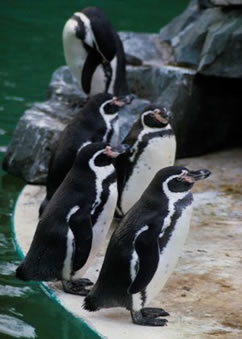
 |
Penguins: North to AlaskaJune 10, 2007Courtesy of Far North Science 
Humboldt penguins are native to the Southern Hemisphere. These Humboldts lived at Stanley Park in Vancouver, BC. The strange appearance of penguins in the Far North didn't occur, for instance, due some bizarre global climatic shift. Or through some extraordinary migration gone 5,000 miles off course.
All about Penguins
Blame the old cute-o-meter.The Penguin Project Dee Boersma talks about penguins Penguin articles & updates This story on Google News "The crews keep the penguins as pets on board the boat. They're appealing," saidAmy Van Buren, a UW doctoral student in biology, in a news release about the findings. "People keep them around because they're so cute." With Dee Boersma, a UW biology professor and noted pengui-phile, Van Buren ruled out migration, escapees from zoos and remnant survivors from long-ago attempts to seed the Pacific Northwest with penguins. But they did find one likely prospect: Stowaways. "The most probable explanation is that the creatures were hauled aboard boats - probably fishing boats - in southern waters and were kept by the crews as the vessels traveled far to the north, then were released," according to the story about their research. Tales of penguins straying north to Alaska have been around for years, according to the researchers. Guy Demmert got quite a surprise when he hauled a fishing net into his boat off the coast of southeast Alaska in July 2002. There among the salmon, in living black and white, was a Humboldt penguin, thousands of miles from where any of its kind should have been. The flightless bird appeared to be healthy and in good condition, and Demmert snapped its picture before turning the bird loose. It wasn't the first sighting of a penguin in Alaskan waters. In fact Demmert himself reported seeing one while fishing in 2001, and in 1976 a research cruise in the Gulf of Alaska recorded the sighting of "brown penguins." (Demmert also caught another rare critter that first day, a green sturgeon, according to the Anchorage Daily News.) One of 17 penguin species, the Humboldt penguin concentrates along the coast of Peru and Chili. The Galapagos penguin has territory that reaches north of the equator to Isabella island in the Galapagos group off Ecuador.
Dee Boersma In the largest sense, penguins in the Far North, if brought by people, would be considered nonindigenous species that could compete for the ecological niche occupied by murres and auks. But penguins seem ill-suited for Far North waters (where they might be vulnerable to predation by bears and other species not present in their native habitats) and have never taken hold despite plenty of attempts.More details from UW science writer Vince Stricherz: There were efforts in the early to mid 20th century to establish breeding penguin colonies in the Northern Hemisphere, mostly in Scandinavia, the researchers noted, but after nearly a decade all the penguins had been killed by predators, died by other means or disappeared. Northern sightings of penguins in the wild have been rare. There was a report of a single Humboldt penguin off British Columbia's Queen Charlotte Islands in 1944; one was reported near Long Beach, Wash., in 1975; three sightings of one to three Humboldts off the coast of Vancouver Island, B.C., were recorded in 1978, with pictures published in local newspapers; and a single penguin was reported off the Washington coast in 1985.
Galapagos Penguin She noted that it is not uncommon for people in the north to mistake some native birds, particularly murres and auks, for penguins. Those birds occupy the same ecological niche in the Northern Hemisphere that penguins do in the south. But in their paper in the June edition of the Wilson Journal of Ornithology, the researchers point out that the south lacks a particular type of predator - bears - that would make penguin survival difficult in the north. They say it is unlikely the Humboldts swam from Peru to the Pacific Northwest, in part because it would mean traversing climate conditions the birds are not well equipped to handle. There also isn't much chance the birds spotted in the wild were zoo escapees, the scientists said. Penguins used to be brought to North American zoos from the south on a regular basis, but those shipments stopped in 1972 with the adoption of international regulations that halted much of the trade. Since then, they said, zoos in the United States have bred penguins in captivity and managed their penguins as one large population, moving individuals from specific zoos to reduce inbreeding. It would not be easy for the birds to escape to the wild from a zoo. "Most zoos use some kind of flipper tag, so a penguin that escaped from a zoo should be able to be identified pretty easily," Van Buren said. She added that the more recent sightings could all have been the same birds, since penguins have been known to live 30 years in the wild. "They could potentially, if they were young birds when they came north in the 1970s, have lived long enough to have been seen in Alaska in 2002," she said. |
|